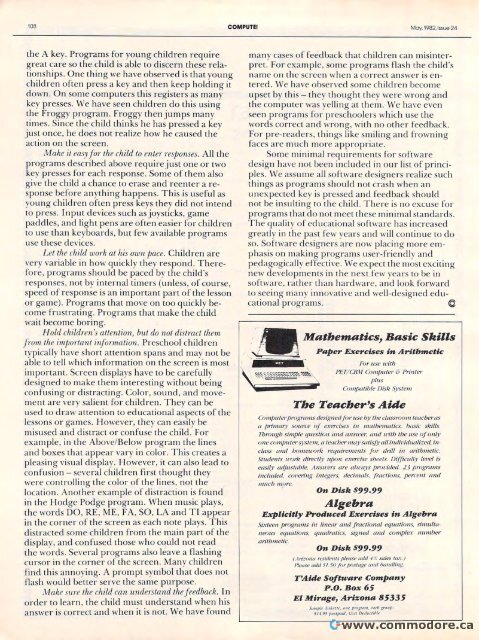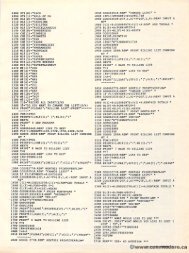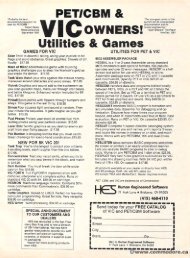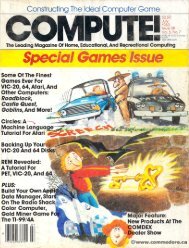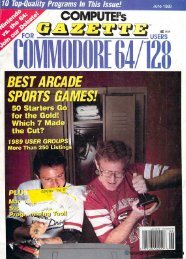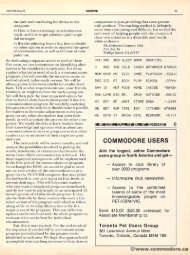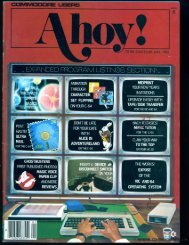Create successful ePaper yourself
Turn your PDF publications into a flip-book with our unique Google optimized e-Paper software.
108 COMPUTEt May. 1Q82.lssue 24<br />
108 COMPUTE! May, 1982, Issue 24<br />
the A key. Programs for young children require<br />
the A key. Programs for young children require<br />
great care so the child is able to discern these relationships.<br />
One thing we have observed is that young<br />
children often press a key and then keep holding it<br />
down. On some computers this registers as many<br />
key presses. We have seen children do this using<br />
the Froggy program. Froggy then jumps many<br />
times. Since the child thinks he has pressed a key-<br />
just once, he does not realize how he caused the<br />
action on the screen.<br />
Make il it eas),/or easy for Ihe the child 10 to enler enter responses. All the<br />
programs described above require just one or two<br />
key presses for each response. Some of them also<br />
give the child a chance to erase and reenter a response<br />
before anything happens. This is useful as<br />
young children often press keys they did not intend<br />
young children often press keys they did not intend<br />
to press. Input devices such as joysticks, game<br />
to press. Input devices such as joysticks, game<br />
paddles, and light pens are often easier forr children<br />
to use than keyboards, but few available programs<br />
to use than keyboards, but few available programs<br />
use these devices.<br />
Let Lei the child work al at his own pace. Children are<br />
very variable in how quicklyy they respond. There<br />
herefore,<br />
programs should be paced by the child's<br />
res po nses, not by internal timers (unless, of course,<br />
responses, not by internal timers (unless, of course,<br />
speed of response is an impon important part of the lesson<br />
or game). Programs that move on too quicklyy become<br />
frustrating. Programs that make the child<br />
wail wait become boring.<br />
Hold I-I children's allention, attention, bul but do 1101 not distract dislracllhem them<br />
from the important information. Preschool children<br />
/rolll Ihe imporlanl in/orlllalio". Preschool children<br />
typically y have short shon attention n spans and may not be<br />
able able to tell which information on the screen is most<br />
important. importanl. Screen displays have to be carefully<br />
y<br />
designed to make them interesting ting without being<br />
confusing or distracting. Color, sound, and movement<br />
are very salient for r children. They can n be<br />
used to draw attention to educational aspects of the<br />
lessons or games. However, they can easily y be<br />
misused and distract or confuse the child. . For<br />
example, in the Above/Below program the lines<br />
and boxes that appear vary in color. This creates a<br />
pleasing visual display. However, it can n also lead to<br />
confusion - several children First Ilrstthought thought they<br />
were controlling the color of the lines, not the<br />
location. Another example of distraction is found<br />
in the Hodge Podge program. When music plays,<br />
the words DO, RE, ME, , FA, SO, LA and TIT I appear<br />
in the e corner of the screen as each note plays. ThisT distracted some children from the main part of the<br />
distracted some children from the main part of the<br />
display, and confused those who could not read<br />
the words. Several programs also leave a flashing<br />
cursor r in the corner of the screen. Many children<br />
find this annoying. A prompt symbol that does not<br />
lind this annoying. A prompt symbol that does not<br />
fl ash wo uld better serve the sa me purpose.<br />
flash would better serve the same purpose.<br />
Make sure Sllre the Ih e child can understand IIndersla the Ihe feedback. In<br />
order o to learn, the child must understand when his<br />
answer is correct and when it is not. We have found<br />
answer is correct and when it is not. We have fo und<br />
many cases of feedback that children ca cann misinterprel.<br />
pret. Forr example, so some programs nash flash the child's<br />
name on the e screen when a COrt-ecl correct answer is en<br />
tered. . We have observed some children become<br />
upset by this -they - thought they were wrong and<br />
the computer was yelling ling at them. We have even<br />
seen programs for preschoolers which use the<br />
seen programs for preschoolers which use the<br />
words correct and wrong. wrong, with no other feedback.<br />
For pre-readers, readers, things like smiling and frowning<br />
faces are much more appropriate.<br />
faces are much more appropri ate.<br />
Some minim al requ irements for softwa re<br />
Some minimal requirements for software<br />
design have not been included in our list of principles.<br />
We assume all software designers realize such<br />
things as programs should not crash when an<br />
unex pected key is pressed and feedback should<br />
unexpected key is pressed and feedback should<br />
not be insulting to thee child. There is no excuse for<br />
programs that do not meet these minimal standards.<br />
programs that do not meet these minimal standards.<br />
The quality of educational software has increased<br />
greatl y in the past few yea rs and will continue to do<br />
greatly in the past few years and will continue to do<br />
so. Software designers are now placing more eem<br />
phasis on makingg programs user-friendly r-Friend and<br />
pedagogically y effective. We expect the most excitingg<br />
new developments in the next few years to be in<br />
software, rather than hardware, and look forward rd<br />
to seeingg many)' innovative ve and well-designed edu-<br />
cational programs. ©<br />
cational programs. ©<br />
i'or For use with ICit/)<br />
PET/CBM PEl/ cml Computer Complller & c- Printer Plilller<br />
plus plltS<br />
Compatible Com/it/riMe Disk Oisk System<br />
,~I'Slem<br />
Computerprograms 0 1111/)1111..'" pIYJ.ltrams designedjbr desiglll..'d /01' use by /).1' tbeclassmom Ibe c1assroomleac/)eras<br />
teacher a primary source of exercises in mathematics, basic skills.<br />
Through simple question and answer, and ivilb the use of only<br />
i(Jlle me computer aml/)IIU'I' system, ,9'Slem, ua teacher 1I'!(lc/)er may 111(1.1' satisfy sati.V), all till individualized, ;lIdiddIlOliz('d, in-<br />
ill·<br />
class cllISS and (ll/d homework /)0I1I('IlYJrk requirements Iw/uiremelllS for drill dlill in ill arithmetic.<br />
mil/)meti(",<br />
Students Slut/ellIs work lI 'fJrk directly d;rec/~J I upon U/JOII exercise eXercise sheets. s/)eets, Difficulty level letlC/ is<br />
easily ('asi~J ' adjustable. m(jus(a/)/c>, Answers A/lslI'ers are always (I"I '(~I 'S provided. tJ/T}II;ded, 23 .!3 programs<br />
tNT/grallls<br />
i'minded, Ineluded, covering cOIlt'liug integers, Inlegers, decimals, decil/wls, fractions, [mf.'liOlls, ficrce?it /H.!/'('elll and (III(/<br />
much mu(,'/) more. mm'l',<br />
Mllthematics, Mathematics, Basic BlISic Skills<br />
Paper Exercises in Arithmetic Aritbmeti


